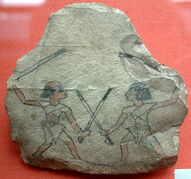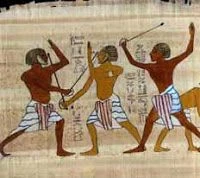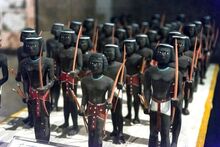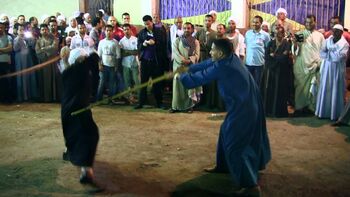One of the oldest recorded martial arts, Tahtib (Egyptian Arabic: تحطيب taḥṭīb) is an African Martial Art originating along the Nile River cultures of Egypt and Nubia. This stick-fighting martial art was originally named fan a'nazaha wa-tahtib ("the art of being straight and honest through the use of stick"). The original martial version of tahtib later evolved into a various folk dances with wooden sticks; Ra's el assaya (Egyptian Dance of the Stick) and the African-American Stick Dance respectively. Although it mostly exists as mock combat accompanied by music, there are still combative branches of the martial art surviving today.
Ancient History[]
The oldest traces of tahtib were found on engravings from the archaeological site of Abusir, an extensive necropolis of the Old Kingdom period, located in the south-western suburbs of Cairo. On some of the reliefs of the Pyramid of Sahure (V dynasty, c. 2500 BC); the images and explanatory captions are particularly precise and accurate in their depiction of what seems to be military training using sticks. Tahtib, with archery and wrestling,

was then among the three disciplines of warfare taught to soldiers.
Three of the 35 tombs of the Beni Hassan necropolis (XI-XII Dynasties, 1900 – 1700 BC) near the town of Minya, contain engravings showing scenes of tahtib. Similar engravings can be seen in the archaeological site

Engravings for Abusir necropolis showing scenes of archery, wrestling, and stick fighting
of Tell el Amarna (XVIII Dynasty, 1350 BC),[10] some 60 km south of Minya. The first evidence of the festive representation of tahtib can only be seen in the New Empire (1500 – 1000 BC), as shown by the engravings on the walls of Luxor and Saqqâra. It is believed that during the ensuing centuries, peasants and farmers from Upper Egypt gradually developed tahtib from a method of military training to a performance art. Early Christian writings mention tahtib as a leisure activity and a popular art performed by men during weddings and celebrations.
Styles[]

It is mainly practiced today in Upper Egypt. A Nubian form of tahtib is regularly performed for tourists in

Aswan. Modern tahti is an attempt to re-explore the sources of tahtib as a fighting art, and to enrich them as a martial art practice by codifying the techniques and teaching them structurally. The main target is the opponent's head, as it is considered the most fragile and

Nubian Soldiers
vulnerable part of the body. Consequently, techniques revolve around protecting one's own head while reaching the head of the opponent. Unlike its traditional counterpart, modern tahtib allows both women and men to practice in mixed groups.
African American Style[]
The stick dance, Tahtib, was practiced in ancient Egypt and survived up until the 19th century across Africa,

African American Variation Brought During the Slave Trade
using a bamboo staff called an asa, asaya, shoum or nabboot. During the slave trade, variations of this martial art were brought to the Americas know as the Stick Dance. African-Americans developed on American plantations during the slavery era, where dancing was used to practise "secret military drills" among the slaves, where the stick used in the dance was in fact a disguised weapon. The stick dance became a standard part of the minstrel shows performed by African-Americans during the late 19th century. It had an element of humour, where the dancer would shuffle onto the stage dressed as an elderly African-American man using a cane, and then suddenly use the cane to perform energetic acrobatic moves.
